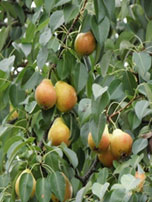SHAHEED KARTAR SINGH SARABHA AYURVEDIC MEDICAL COLLEGE & HOSPITAL
Affiliated to Guru Ravidas Ayurved University, Hoshiarpur Punjab
Affiliated to Guru Ravidas Ayurved University, Hoshiarpur Punjab

Botanical Name : Pyrus communis
Family : Rosaceae
Morphology :
A medium sized deciduous tree, reaching 7-10 m tall often with a tall, narrow crown. The leaves are alternately arranged, simple, 2-12 cm long, glossy green on some species or dense silvery-hairy in some others, shape varies from broad oval to narrow lanceolate. The flowers are white, rarely tinted yellow or pink, 2-4 cm in diameter and have five petals. The fruit is globose and is composed of the receptacle or upper end of the flower-stalk greatly dilated. Enclosed within its cellular flesh is the true fruit
Uses :
Considered to have diuretic properties and stimulates the urine elimination. Also have analgesic properties.
In external use, the bark is used in decoctions and believed to mitigate the pains produced by blows, twists, sprains and bruises etc
Aerial and flowering parts of Pyrus communis are a source of folk medicine as they show anti-inflammatory effects.
Pears astimulate bowel peristaltic movement and digestion, affect blood pressure, low in calories, and show antipyretic, diuretic, and antitussive activities .
Its bark and leaves can be used in healing of wound.
Among the Arabs, buds, bark,and leaves of the tree are domestic remedies for their astringent effect.
The pear flowers are used in traditional medicine as components of spasmolytic and analgesic drugs
Phytochemical composition :
Pyrus communis contain many active constituents such as glycosides, minerals, vitamins, amino acids,flavonoids,fatty acids, alkaloids, tannins and polyphenols
Study show that in ethanolic extract of Pyrus communis, the nature of active constituents present are
carbohydrates, tannins, alkaloids, phenolics, glycosides and flavonoids. The nature of active constituents truant in ethanolic extract are proteins, amino acids, fixed oils,triterpenoids, steroids, saponins, mucilage and gums.
Different parts of pear such as flowers, leaves, bark and roots use as anti-inflammatory agents against disorders. The leaves contain many active compounds such as arbutin, sorbitol, isoquercitrin, ursolic acid, tannin and astragalin .
The bark is source of bioactive compounds like epifriedelanol, friedelin and beta-sitosterol
The fruit is a good source of phytonutrients like carotenoids, glycosides, flavonoids,
carbohydrates,sterols and phenolic compounds such as epicatechin, arbutin, hydroxyl-phenolic acids and health promoting nutrients such as minerals, vitamin C,A, organic
Traditional Uses :
Aerial and flowering parts of Pyrus communis are a source of folk medicine as they show anti-inflammatory effects .
Pears are stimulate bowel peristaltic movement and digestion, affect blood pressure, low in calories, and show antipyretic, diuretic, and antitussive activities .
Its bark and leaves can be used in healing of wound. Among the Arabs, buds, bark, and leaves of the tree are domestic remedies for their astringent effect .
The pear flowers are used in traditional medicine as components of
spasmolytic and analgesic drugs ,acid,dietary fiber etc .
Its fruits help in maintaining balance of desirable acid in the body because they are excellent
source of pectin .
Fruit also contains some essential element enough to meet with the allowances of recommended daily like phosphorus, calcium, sodium and magnesium The juice of Pyrus communis contains vitamins and carotenoids, that have neuroprotective and antioxidant property that prevent the apoptosis of neurons
